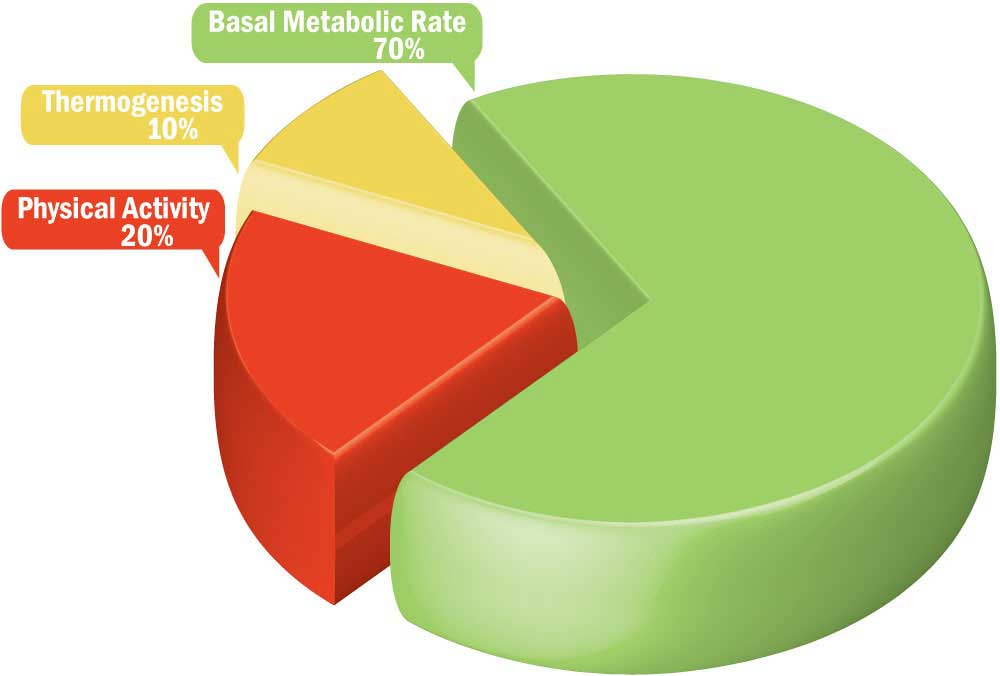What is BMR (Basal Metabolic Rate)?
Calories “you burnt while sitting idle” is BMR: the Basal Metabolic Rate.
Basal means base – you can think of them as the number of calories enough to cover all your own body’s bases.
To simplify further, even when you are sitting idly on a chair, your heart is pumping, lungs breathing and other organs working. Now whatever calories your body burns to keep all this happening adds up to your basal metabolic rate, or BMR.
To add more, it totals from 60-75 % of total calories you consume daily without doing anything.
BMR helps you create an effective strategy for weight loss. You can keep your calorie count on track and know in advance, which exercise will have what effect on your tummy.
How to Calculate BMR?
 Normally, it is best to use an online calculator. They rope in your height, weight, gender, age and then assess how many calories you will need to eat so that you can maintain your current weight, while doing nothing!
Normally, it is best to use an online calculator. They rope in your height, weight, gender, age and then assess how many calories you will need to eat so that you can maintain your current weight, while doing nothing!
If you are good in mathematics, try this formula.
For Men: BMR = 66 + (6.23 x weight in pounds) + (12.7 x height in inches) – (6.8 x age in years).
For example, if your weight 90 kilograms (90 x 2.2 = 198 pounds), height=6ft, and age=45 then
BMR = 66 + (6.23 x 198) + (12.7 x 72) – (6.8 x 45) = 66 + 1233.54 + 914.4 – 306 = 1907.94 calories.
For Women: BMR = 655 + (4.35 x weight in pounds) + (4.7 x height in inches) – (4.7 x age in years)
For example, if the women weight 80 kilograms (80 x 2.2 = 176 pounds), height = 5’4” and age=36 then
BMR = 655 + (4.35 x 176) + (4.7 x 64) – (4.7 x 36) = 655 + 765.6 + 300.8 – 169.2 = 1963.6 calories.
These are the basic calories you need while not doing anything.
What if you do some exercises? Find the calories needed by using the following:
- If you exercise once in a while, multiply your BMR by 1.2
- If you exercise up to 3 days in a week, multiply your BMR by 1.375
- If you really exercise 3 to 5 days a week, then multiply your BMR by 1.55
- If you exercise all days of the week, multiply your BMR by 1.725
- If you exercise daily and also have a physical job or if you are a fitness fanatic and exercise twice a day, multiply your BMR by 1.9
Now you know how many calories you need for the described level of activity and you will maintain your weight if you keep your life that way.
Weight Gain OR Weight Loss is possible using the calculated BMR
Read the above table carefully and you know how many calories you should increase or decrease to gain weight or lose weight. For example, improve your weight loss efforts by increasing your physical activity and reducing your calories and you are good to achieve your target.
Recommended: Best weight gain supplements without side effects
Recommended: Best weight loss supplements without side effects
To reduce 1 kilo in 10 days:
- Reduce your calorific intake below the calculated BMR value by 700 calories and you will reduce 1 kg every 10 days.
- The calculators look for your level of physical activity for a valid reason. Increase your exercise and you burn even more calories.
Why Men Enjoy Higher BMR than Women
Men tend to have more muscle mass than women (who have more fat). Muscles at rest burn more than calories than fat and this is the reason why men enjoy higher BMR.
The advantage of knowing your BMR is that you can adjust the number of calories of any diet you choose to meet your personal guidelines for weight loss or weight gain.
Easier Weight Gain
Increasing calories is much easy than reducing. This task is made easy if you add any weight gainer supplement. You will be surprised why we say so!
Instead of eating any junk, it is better to put on healthy weight. Weight Gainers are scientifically formulated to help you increase your calories.
What is BMI (Body Mass Index)?
Body Mass Index, is a scale that helps to show body fat composition. The previously talked about BMR, in comparison, is a measure of the amount of energy our body needs for important bodily functions. The relation between the two is: higher the body composition, the higher the BMR.
How to Calculate BMI?
 Divide your current weight in pounds by your height in inches squared and multiply the result with 703. Displaying this equation will look like (weight / height x height) * 703.
Divide your current weight in pounds by your height in inches squared and multiply the result with 703. Displaying this equation will look like (weight / height x height) * 703.
An example would be: if you are 6 feet (72 inches), and your current weight is 176 pounds (80 kilos), your BMI would come to something like:
(176 / (72 * 72) = 176/5184 = .03. Multiply it by 703 which gives us = .03 x 703 = 23.86
This is in the normal range.
A BMI below 18.5 indicates that you are underweight; between 18.5 and 24.9 shows you as having normal weight; between 25 and 29.9 puts you in the overweight category; and lastly a BMI of 30 or above classifies you as obese.
Limitations of BMI
BMI is used only as a screening tool and not considered as a diagnostic test. Since BMI uses only height and weight, it does not account for people with below-average height but above-average muscle mass, like bodybuilders and resistance trainers. If a man has a lot of muscle, which is denser than fat, his BMI may categorize him as overweight, when her weight is actually healthy.
BMI also doesn’t take into account either age or gender. Women all around the globe naturally have more body fat than men, and elderly tend to have more body fat than youngsters. So a sedentary older woman with low muscle mass may be overly fat, even though she has a normal BMI.
Conclusion
BMI and BMR are just guidelines that allow nutrition and medical professionals to make educated determinations about body composition and calorie burn rate. We feel every person should still be viewed individually and not clubbed for calculating any result.







